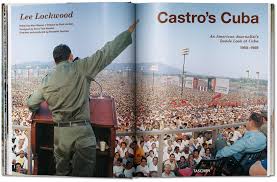Revered Cuban crooner Beny More held a Frank Sinatra-like stature in mid-century Cuban pop culture.
In the mid-Fifties, as an adolescent refugee growing up in Chicago, I developed what has turned out to be a life long interest in Cuba—which has been amplified by an inchoate fascination manifest with the gem of the Caribbean in the USA at large. Since the recent detente (the Cuba Thaw) interest has grown exponentially. And as such there are always additions being made to a huge Cuba data base.
Young photographerLee Lockwood arrived in Cuba on December 31, 1958, one day before Fidel Castro ousted US puppet dictator Fulgencio Batista. Since then Lockwood has had unimpeded access to the island nation. In 1965 ,Lockwood conducted an in-depth interview over a seven days which stands as one of the more useful snapshots of the mind of Castro. This tome was originally published in 1967 and in its current 400 page iteration we have photographs from the extensive period Lockwood traveled with Fidel,and from the special access to the Maximum Leader’s inner circle and a broad array of images from Sierra Maestra military camps to life on Havana’s streets and the endless political rallies and celebrations. Many of these images have never been published before. Historian/filmmaker Saul Landau ,whose films include the 1968 documentary, Fidel! provides elucidating commentary.
Eschewing the role of a Castro apologist, Lockwood explains his purpose for the book project.:
“If he is really our enemy, as dangerous to us as we are told he is, then we ought to know as much about him as possible…I was amazed at the apparent discrepancies that existed between what was popularly being said and believed about Cuba in the United States and what I actually saw … After three weeks of traveling, including an eight-day, cross-country trip taken in Castro’s company, I could find little evidence of the standard image of Cuba so luridly painted by American newspapers and magazines — that of a crumbling economy, a populace in tatters and near starvation, and a political regime that had lost its popular support and was maintaining itself in power through oppression and terror. Instead, I found that, in spite of rationing, people were well-clothed and adequately fed, nearly everyone was working and had money and — contrary to all pronouncements by our State Department — Castro still enjoyed the support, even the affection, of the great majority of Cubans.
There is ample evidence that US attitudes and perceptions of Cuba are as suspended in the mid-century as the cars that transverse Cuban roadways…
Below some images from Castro’s Cuba…
Esteemed translator Esther Allen (who is reportedly readying a biography of hemispheric iconic figure Jose Marti) offers a smart and useful perspective on Lockwood’s work and the resonant role of Fidel. She concludes:
Classic twentieth-century dictators of all ideological stripes left statues of themselves in the central squares, to be gilded, pulled down, or both, by those who came after. Through more than half a century as the nation’s leader, Fidel never did. Lockwood’s photos now remind us of this: though he never learned to relinquish power, Fidel did somehow learn to disappear.*
If anyone is going to unpack the features of USA’s byzantine relationship with Cuba and the dance steps of The Cuban Thaw Tango, Jon Lee Anderson is that person. A well-traveled journalist and no stranger to this planet’s sites of extreme belligerence, Anderson has penned the definitive biography of Che Guevera** having established residence in Havana with his family to research and write. His recent wide-ranging report*** includes this insight
In the Oval Office, Obama told me he believed that Americans needed to make a greater effort to acknowledge perceptions that exist outside the United States. “We are a superpower, and we do not fully appreciate the degree to which, when we move, the world shakes,” he said. “Our circumstances have allowed us to be ahistorical. But one of the striking things when you get outside the United States is—Faulkner’s old saying, ‘The past is never dead. It isn’t even past.’ . . . People remember things that happened six hundred years ago. And they are alive and active in their politics.
“And so the intention here is not, as the Republicans like to call it, engaging in apology tours. It is dignifying these countries’ memories and their culture, and saying to them, ‘We understand your experience and your culture, and that is valid.’ And, once you do that, if people think, he sees me, even if they disagree with you, there is an openness to having a conversation.”
#######################
END notes
*Esther Allen elucidates Lee Lockwood’s Castro ‘s Cuba
** Talking Cuba and Che with Jon Lee Anderson
***Jon Lee Anderson’s “A New Cuba: President Obama’s plan normalized relations. It may also transform the nation”





